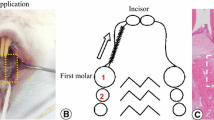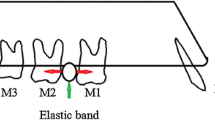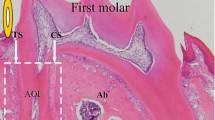Abstract
Objectives
Recent studies indicate that high mobility group box protein 1 (HMGB1) can be released by necrotic and damaged cells and functions as an alarmin that is recognized by the innate immune system. Little is known about the role of HMGB1 within the periodontal ligament (PDL). Therefore, we examined HMGB1 expression by PDL cells in vitro and compared the findings to an in vivo model of orthodontically induced tooth root resorption. In addition, we addressed the question of whether a potentially anabolic intermittent administration of parathyroid hormone (iPTH) would modulate the expression of HMGB1.
Materials and methods
In confluent PDL cell cultures, HMGB1 messenger RNA (mRNA) expression was quantified by real-time polymerase chain reaction. In a rat model comprising 25 animals, mechanical loading for 5 days was followed by administration of either iPTH (1–34) systemically or sham injections for up to 56 days. HMGB1 expression was determined by means of immunohistochemistry and histomorphometry.
Results
The in vitro experiments revealed an inhibitory effect of iPTH on basal HMGB1 mRNA expression in confluent PDL cells. In vivo, the mechanical force-induced enhanced HMGB1 protein expression declined time dependently. Intermittent PTH further inhibited HMGB1 expression. The significantly higher basal HMGB1 protein expression in the former compression side was followed by a more pronounced time- and iPTH-dependent decline in the same area.
Conclusions
These data indicate a major role for HMGB1 in the regulation of PDL wound healing following mechanical load-induced tissue injury.
Clinical relevance
The findings point to the potential benefit of iPTH in the attempt to support these immune-associated reparative processes.






Similar content being viewed by others
References
Ranzato E, Patrone M, Pedrazzi M et al (2010) Hmgb1 promotes wound healing of 3 T3 mouse fibroblasts via RAGE-dependent ERK1/2 activation. Cell Biochem Biophys 57:9–17
Straino S, Di Carlo A, Mangoni A et al (2008) High-mobility group box 1 protein in human and murine skin: involvement in wound healing. J Invest Dermatol 128:1545–1553
Dumitriu IE, Baruah P, Valentinis B et al (2005) Release of high mobility group box 1 by dendritic cells controls T cell activation via the receptor for advanced glycation end products. J Immunol 174:7506–7515
Ulloa L, Messmer D (2006) High-mobility group box 1 (HMGB1) protein: friend and foe. Cytokine Growth Factor Rev 17:189–201
Charoonpatrapong K, Shah R, Robling AG et al (2006) HMGB1 expression and release by bone cells. J Cell Physiol 207:480–490
Yang J, Shah R, Robling AG et al (2008) HMGB1 is a bone-active cytokine. J Cell Physiol 214:730–739
Kim YS, Lee YM, Park JS et al (2010) SIRT1 modulates high-mobility group box 1-induced osteoclastogenic cytokines in human periodontal ligament cells. J Cell Biochem 111:1310–1320
Morimoto Y, Kawahara KI, Tancharoen S et al (2008) Tumor necrosis factor-alpha stimulates gingival epithelial cells to release high mobility-group box 1. J Periodontal Res 43:76–83
Ebe N, Hara-Yokoyama M, Iwasaki K et al (2011) Pocket epithelium in the pathological setting for HMGB1 release. J Dent Res 90:235–240
Feghali K, Iwasaki K, Tanaka K et al (2009) Human gingival fibroblasts release high-mobility group box-1 protein through active and passive pathways. Oral Microbiol Immunol 24:292–298
Brezniak N, Wasserstein A (2002) Orthodontically induced inflammatory root resorption. Part II: the clinical aspects. Angle Orthod 72:180–184
Krishnan V, Davidovitch Z (2006) Cellular, molecular, and tissue-level reactions to orthodontic force. Am J Orthod Dentofacial Orthop 129(469):e1–e32
Taithongchai R, Sookkorn K, Killiany D (1996) Facial and dentoalveolar structure and the prediction of apical root shortening. Am J Orthod Dentofacial Orthop 110:296–302
Owman-Moll P, Kurol J (1998) The early reparative process of orthodontically induced root resorption in adolescents—location and type of tissue. Eur J Orthod 20:727–732
Chen SC, Marino V, Gronthos S et al (2006) Location of putative stem cells in human periodontal ligament. J Periodontal Res 41:547–553
Chou AM, Sae-Lim V, Lim T et al (2002) Culturing and characterization of human periodontal ligament fibroblasts—a preliminary study. Mater Sci Eng 20:77–83
Nagatomo K, Komaki M, Sekiya I et al (2006) Stem cell properties of human periodontal ligament cells. J Periodontal Res 41:303–310
Seo BM, Miura M, Gronthos S et al (2004) Investigation of multipotent postnatal stem cells from human periodontal ligament. Lancet 364:149–155
Trubiani O, Di Primio R, Traini T et al (2005) Morphological and cytofluorimetric analysis of adult mesenchymal stem cells expanded ex vivo from periodontal ligament. Int J Immunopathol Pharmacol 18:213–221
Nohutcu RM, Somerman MJ, McCauley LK (1995) Dexamethasone enhances the effects of parathyroid hormone on human periodontal ligament cells in vitro. Calcif Tissue Int 56:571–577
Ouyang H, McCauley LK, Berry JE et al (2000) Response of immortalized murine cementoblasts/periodontal ligament cells to parathyroid hormone and parathyroid hormone-related protein in vitro. Arch Oral Biol 45:293–303
Lekic PC, Rajshankar D, Chen H et al (2001) Transplantation of labeled periodontal ligament cells promotes regeneration of alveolar bone. Anat Rec 262:193–202
Sone T, Fukunaga M, Ono S et al (1995) A small dose of human parathyroid hormone (1–34) increased bone mass in the lumbar vertebrae in patients with senile osteoporosis. Miner Electrolyte Metab 21:232–235
Verhaar HJ, Lems WF (2010) PTH analogues and osteoporotic fractures. Expert Opin Biol Ther 10:1387–1394
Barros SP, Silva MA, Somerman MJ et al (2003) Parathyroid hormone protects against periodontitis-associated bone loss. J Dent Res 82:791–795
Marques MR, da Silva MA, Manzi FR et al (2005) Effect of intermittent PTH administration in the periodontitis-associated bone loss in ovariectomized rats. Arch Oral Biol 50:421–429
Bashutski JD, Eber RM, Kinney JS et al (2010) Teriparatide and osseous regeneration in the oral cavity. N Engl J Med 363:2396–2405
Lossdorfer S, Gotz W, Jager A (2005) PTH (1–34) affects osteoprotegerin production in human PDL cells in vitro. J Dent Res 84:634–638
Lossdorfer S, Gotz W, Rath-Deschner B et al (2006) Parathyroid hormone (1–34) mediates proliferative and apoptotic signaling in human periodontal ligament cells in vitro via protein kinase C-dependent and protein kinase A-dependent pathways. Cell Tissue Res 325:469–479
Lossdorfer S, Gotz W, Jager A (2011) PTH (1–34)-induced changes in RANKL and OPG expression by human PDL cells modify osteoclast biology in a co-culture model with RAW 264.7 cells. Clin Oral Investig 15:941–952
Lossdörfer S, Kraus D, Abuduwali N et al (2011) Intermittent PTH(1–34) regulates the osteoblastic differentiation of human periodontal ligament cells via protein kinase C- and protein kinase A-dependent pathways in vitro. J Periodontal Res 46:318–326
Lossdorfer S, Kraus D, Jager A (2010) Aging affects the phenotypic characteristics of human periodontal ligament cells and the cellular response to hormonal stimulation in vitro. J Periodontal Res 45:764–771
Livak KJ, Schmittgen TD (2001) Analysis of relative gene expression data using real-time quantitative PCR and the 2(-delta delta C(T)) method. Methods 25:402–408
Lossdorfer S, Yildiz F, Gotz W et al (2010) Anabolic effect of intermittent PTH (1–34) on the local microenvironment during the late phase of periodontal repair in a rat model of tooth root resorption. Clin Oral Investig 14:89–98
Waldo CM, Rothblatt JM (1954) Histologic response to tooth movement in the laboratory rat; procedure and preliminary observations. J Dent Res 33:481–486
Sato M, Vahle J, Schmidt A et al (2002) Abnormal bone architecture and biomechanical properties with near-lifetime treatment of rats with PTH. Endocrinology 143:3230–3242
Gotz W, Kunert D, Zhang D et al (2006) Insulin-like growth factor system components in the periodontium during tooth root resorption and early repair processes in the rat. Eur J Oral Sci 114:318–327
Jager A, Kunert D, Friesen T et al (2008) Cellular and extracellular factors in early root resorption repair in the rat. Eur J Orthod 30:336–345
Bianchi ME (2007) DAMPs, PAMPs and alarmins: all we need to know about danger. J Leukoc Biol 81:1–5
Savill J, Dransfield I, Gregory C et al (2002) A blast from the past: clearance of apoptotic cells regulates immune responses. Nat Rev Immunol 2:965–975
Gotz W, Lossdorfer S, Kruger U et al (2003) Immunohistochemical localization of insulin-like growth factor-II and its binding protein-6 in human epithelial cells of Malassez. Eur J Oral Sci 111:26–33
Meghji S, Qureshi W, Henderson B et al (1996) The role of endotoxin and cytokines in the pathogenesis of odontogenic cysts. Arch Oral Biol 41:523–531
Liu F, Abiko Y, Nishimura M et al (2001) Expression of inflammatory cytokines and beta-defensin 1 mRNAs in porcine epithelial rests of Malassez in vitro. Med Electron Microsc 34:174–178
Ohshima M, Nishiyama T, Tokunaga K et al (2000) Profiles of cytokine expression in radicular cyst-lining epithelium examined by RT-PCR. J Oral Sci 42:239–246
Kale S, Kocadereli I, Atilla P et al (2004) Comparison of the effects of 1,25 dihydroxycholecalciferol and prostaglandin E2 on orthodontic tooth movement. Am J Orthod Dentofacial Orthop 125:607–614
Rincon JC, Young WG, Bartold PM (2006) The epithelial cell rests of Malassez—a role in periodontal regeneration? J Periodontal Res 41:245–252
Jager A, Radlanski RJ, Gotz W (1993) Demonstration of cells of the mononuclear phagocyte lineage in the periodontium following experimental tooth movement in the rat. An immunohistochemical study using monoclonal antibodies ED1 und ED2 on paraffin-embedded tissues. Histochemistry 100:161–166
Pacifici R (2010) T cells: critical bone regulators in health and disease. Bone 47:461–471
Pacifici R (2010) The immune system and bone. Arch Biochem Biophys 503:41–53
Acknowledgments
The authors thank Mrs. Schaffrath for expert technical assistance and the German Research Foundation (DFG) as well as the Medical Faculty of the University of Bonn for providing a research grant (KFO 208, TP8, LO-1181/2-2). The authors declare that they have no conflict of interest.
Author information
Authors and Affiliations
Corresponding author
Additional information
M. Wolf and S. Lossdörfer contributed equally to this work.
Rights and permissions
About this article
Cite this article
Wolf, M., Lossdörfer, S., Abuduwali, N. et al. Potential role of high mobility group box protein 1 and intermittent PTH (1–34) in periodontal tissue repair following orthodontic tooth movement in rats. Clin Oral Invest 17, 989–997 (2013). https://doi.org/10.1007/s00784-012-0777-2
Received:
Accepted:
Published:
Issue Date:
DOI: https://doi.org/10.1007/s00784-012-0777-2




